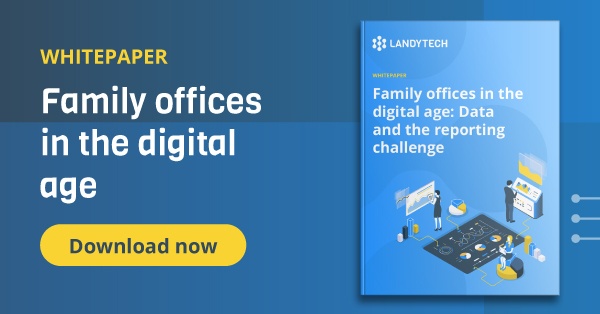Written by Landytech
12 Jan 2023After almost two years of record returns, market volatility and the looming threat of recession has left family offices anxious. Amid continued inflationary pressure and lower expected returns, some are looking to increasingly exotic portfolio diversifiers for outsized returns, whilst others seek to reduce risk and play it safe. All, however, are seeking opportunities to streamline their operations, against a backdrop of rising costs.
As family offices deliberate on how best to navigate the choppier waters ahead, here are five ways that data and technology can help you stay on the front foot in this rapidly changing environment.
1.Finding operational efficiency
According to the 2022 UBS Global Family Office Report , staffing costs already make up 69% of overall operating costs for family offices, with 54% of family offices expecting these to rise further amid ongoing inflationary pressure. As these costs rise, family offices are looking for ways to reduce their surging overheads.
For family offices that use disparate systems and spreadsheets with highly manual data management and reporting processes, across various disparate systems and spreadsheets, the only way to scale operations is to hire more staff. This places an even greater burden on their bottom line.
To counteract these rising costs, family offices are looking to streamline manual processes and unlock time for what they do best, managing family portfolios and risk. When it comes to non-core activities such as multi-asset class data management and reporting, that means increasingly turning to technology.
The latest family office platforms enable them to automate many of those processes, with direct connections to banks and custodians, and solutions for private asset coverage. Not only does this counteract the need for family offices to hire new staff as family portfolios grow in complexity, or in the case of multi-family offices, new clients are acquired. It also frees up existing staff from mundane bookkeeping and data consolidation to focus on more value-added activities and reduce key-person risk.
2. Identifying opportunities in the chaos
Financial markets are facing one of the most uncertain periods in decades. Against a backdrop of rampant inflation and interest rate rises, family offices are reviewing their asset allocations as traditional equities and fixed income performance trends downwards.
With family offices enjoying much more flexibility in their investment strategies, compared to the likes of pension funds and endowments, many are looking to opportunities in more niche investments for growth.
As family offices look for these uncorrelated returns, they are increasingly turning to private equity, real estate and private debt, as well as exploring other possibilities such as digital assets.
The ability to make swift investment decisions, in addition to reporting on these classes, requires family offices having access to reconciled, timely, accurate data across multiple asset classes, just like they do with more traditional investments.
3. Reporting on these new asset classes
The addition of these asset classes is placing an increasing burden on data management and reporting processes. Family investments begin to span more complex asset classes and numerous geographies, not to mention multiple fund and asset managers, banks, custodians and brokers. Creating a consolidated, on-demand view of portfolio performance and visually simplifying such a complex investment picture is essential to enabling effective monitoring and informed decision making.
As many alternative and private assets are non-custodied, family offices need scalable solutions to account for this information. Capturing this disparate data, then having the tools to configure and represent it in an intelligible way within the family office and to end-family clients to give a clear picture of wealth is one of the biggest challenges to overcome. But the right technology stack can give complete coverage across all assets and liabilities, include private assets and collectibles, to give families the complete picture and enable decisive action.
4. Risk management
Effective risk management is dependent on understanding a portfolio’s full structure alongside its breakdown across multiple asset classes, geographies and currencies. As family offices pursue higher risk-adjusted returns, this can become even more complex to manage than with traditional ‘balanced’ portfolios. Especially as they seek to incorporate exposures, risk contributions, and liquidity analysis into their portfolio analysis.
In the 2022 UBS Global Family Office Report, 37% of family offices say they are now willing to accept managing more portfolio risk to get previously achieved returns, whilst 54% are already managing portfolio risk more actively than in previous years.
77% of family offices still handle the investment risk function in-house. But to account for the additional data and analytics they need to effectively manage riskier and more complex investments, they are seeking the help of third-party providers to help them develop an institutional-grade risk function and monitor risk effectively. A recent report by EY indicated that over 90% of family offices are looking to external partners for help with risk management.
5. Transparent Reporting
Transparent reporting is a vital contributor to maintaining strong relationships with families, especially when portfolio performance has been struggling. During periods of market volatility, families will seek reassurance that any underperformance is temporary. Feeling confident they are not being misled on performance or that anything is being hidden is crucial. Transparent and easy to understand reporting go a long way to providing that confidence.
The latest technology can provide families with a holistic view of their wealth, through visual ownership mapping so that performance and risk analysis can be grouped by legal entities, trusts, holding companies and any other vehicles. Drill down functionality provides the opportunity to analyse at any holding or asset class level.
Looking to the future
With uncertainty only set to continue, there are no easy options for family offices. But there is one thing that family offices can be sure of.
As portfolios are diversified and operational efficiencies need to be found, by getting bogged down in data sourcing and manual reporting. If they don’t the danger is that they end up creating additional cost, instead of focusing on the thing that matters most: preserving and growing family wealth for generations to come.
Find out how family offices are using technology to save time on data management and reporting in our whitepaper.
Related Content

The Top 10 Family Office Trends in 2026
Family offices are under pressure from all sides. Markets are more complex, families are more global, and expectations around transparency and control keep rising. In response, many offices are refocusing on a smaller number of technology...

How your family office should be sourcing wealth data
As today’s UHNW become more geographically dispersed and family officesbecome more sophisticated in their investment functions and allocation strategies,portfoliosnowconsist of multiple asset classes, custodians and currencies, and investments...
-1.jpg)
5 ways to improve productivity in your family office
As family offices attempt to modernise, many are facing productivity challenges due to out-of-date, disparate internal systems andheavily manual processes. Naturally, there are inherent risks associated with such inefficiencies, including missed ...




